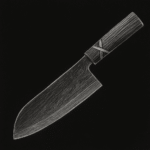三徳包丁 (さんとく) Santoku Bōchō
Läänelik stiil
Kala, köögiviljad
130mm kuni 200mm
Mis on Santoku?

Santoku nuga – kirjutatud jaapani keeles 三徳包丁 (さんとく) ja hääldatakse Santoku Bōchō. See on läänelikus stiilis jaapani kööginuga, mille pikkus on tavaliselt 130mm kuni 200mm. Sel juhul soovitame kõige sobivamaks suuruseks umbes 165mm. Seda nuga on parim kasutada kala ja köögiviljade jaoks. Santoku on mitmekülgne jaapani nuga, mis on kuulus oma nime “kolm voorust” tõlke tõttu. Need kolm voorust viitavad Santoku mitmekülgsusele kasutamiseks tükeldamisel, viilutamisel ja hakkimisel või peamistele koostisosadele, mida sellega saab lõigata: kala, liha ja köögiviljad.
Santoku iseloomustavad selle sirge lõikeserv ja lai sheepsfoot tera, mille selgroog kaardub allapoole, et saavutada ümardatud ots. Santoku lame profiil sobib hästi koputustükeldamise või tõmbelõikamise tehnikate jaoks, kuid selle sirge esiserva puudumine ei võimalda kivilõikamist. Santoku on tavaliselt ühe kaldega nuga, kuigi kahekaldelised noad on muutumas tavaliseks tänu Santoku kasvavale populaarsusele lääne maailmas.
Santoku on kõige populaarsem nuga Jaapanis ja seda võib leida peaaegu igas majapidamises. Seda soovitatakse sageli kompaktsema jaapani alternatiivina klassikalisele lääne kokanoale ehk Gyutole. Võrreldes klassikalise lääne kokanoaga on Santoku lühem, kergem, õhem ja kasutab kõvemat terast.
Santoku noad ilmusid esmakordselt Jaapanis pärast Teist maailmasõda 20. sajandi keskel. Need kujundati kodukoka alternatiivina Nakirile, traditsioonilisele jaapani köögiviljatükeldajale. Säilitades Nakiri kõrge kõrguse ja sirge lõikeserva, kuid lisades kerge allapoole kaardumise selgroost ümardatud tipuni, muutus Santoku järk-järgult kõige populaarsemaks noaks jaapani kodudes kui nutikas ja kompaktne universaalnuga.
Mida tähendab sõna Santoku?
Sõna-sõnalt tõlgituna tähendab ‘Santoku’ jaapani keeles ‘kolm voorust’, viidates selle mitmekülgsusele. Kolm voorust tähistavad selle mitmekülgset kasutamist viilutamisel, hakkimisel ja tükeldamisel või alternatiivselt erinevaid toiduaineid, mille jaoks see on mõeldud: liha, kala ja köögiviljad.
Santoku mitmeotstarbeline olemus viib sageli selle võrdlemiseni lääne kokanoa või Gyutoga. Santoku ajalugu ulatub siiski tagasi 20. sajandi keskpaika, kui see esmakordselt ilmus kodukoka alternatiivina Nakirile, traditsioonilisele jaapani köögiviljatükeldajale. Võttes inspiratsiooni Nakiri kõrgest terakõrgusest ja sirgest lõikeservast, lisas Santoku disain allapoole kaardumise selgroo suunas, moodustades “sheepsfoot” tipu, ning nii sündis populaarne mitmeotstarbeline Santoku.
Milleks on Santoku nuga parim?
Oma nimele truuks on Santoku nuga parim liha, kala ja köögiviljade tükeldamiseks, viilutamiseks ja hakkimiseks. Terav, õhuke tera koos Santoku sirge lõikeservaga muudab selle ideaalseks tööriistaks kiirete puhaste lõigete tegemiseks üles-alla liikumisega või koputustükeldamise või tõmbelõikamise tehnikatega.
Santoku kõrget ja lamedat profiili täiendab õhuke ja terav sheepsfoot tera, mis sobib hästi õhukeste viilude loomiseks lihast, mereandidest, juustust, puuviljadest ja köögiviljadest. Lai tera on kasulik toidu lõikelaudalt tõstmiseks.
Nagu teised traditsioonilised jaapani noad, on ka Santoku algselt ühe kaldega nuga, mis teeb selle ideaalseks tööriistaks puhaste lõigete saavutamiseks, säilitades toidu loomuliku värskuse, maitse ja tekstuuri, kuna ainult tera lõikeserv puudutab toitu. Tänapäeval on Santoku saadaval ka kahekaldeliste versioonidena, kuid säilitab jaapani nugade iseloomuliku terava serva, kuna tera on lihvitud palju teravama nurga all (tavaliselt 10-15 kraadi) kui lääne kokanoad.
Kuna Santoku nuga on tavaliselt lühem võrreldes lääne kokanoaga, on see märkimisväärselt kergem ja lihtsam käsitseda – eriti väikeste kätega inimestele.
Santoku noa omadused
Santoku on suhteliselt lühem kui tavaline lääne kokanuga, enamik terade pikkusi jäävad vahemikku 130-200mm – umbes keskmise täiskasvanu käe pikkus. Selle kompaktne pikkus koos tera õhukesusega muudab Santoku väiksemaks ja kergemaks kui kokanuga, muutes selle ideaalseks valikuks neile, kellel on väiksemad käed või kes soovivad vähendada väsimust ja pinget, kui nuga kasutatakse pikka aega.
165mm on soovitatav kõige sobivam terapikkus kodukokkadele ja professionaalidele, kuna see on piisav ja mugav suurus enamiku toiduainete käsitlemiseks, hoides noa samal ajal kompaktse ja lihtsasti käsitsetavana.
Tuginedes oma algsele inspiratsioonile jaapani köögiviljatükeldajalt Nakirilt, iseloomustab Santokut lamedam lõikeserv, mis on peaaegu sirge kannast tipuni. Kerge allapoole kaarduv selgroog viib selle ümardatud otsani, andes Santokule oma iseloomuliku sheepsfoot tera kuju. Õhuke tera võib sisaldada grantoneid (tuntud ka kui õõnsused, lohud või kumerused) tera pikkuses, et vähendada hõõrdumist ja aidata toitu noa küljest hõlpsasti lahti lasta tükeldamisel ja viilutamisel.
Santoku lame profiil muudab selle suurepäraseks kiireks allapoole lõikamiseks ja sobib hästi koputustükeldamise või tõmbelõikamise tehnikate jaoks, kuid sirge esiserva puudumine ei võimalda kivilõikamist. Kuigi paljud lääne kokad on koolitatud kasutama kivilõikemeetodit, on Santoku lõikamise viis kiirem ja tõhusam.
Kuna traditsiooniline jaapani toitumine koosnes peamiselt kalast ja pehmetest köögiviljadest, olid Santoku noad disainitud õhemate terade ja kergema kaaluga, et saavutada delikaatsemad lõiked, eelistades peenust pigem kui noa üldist jõudu. Tänapäeva Santoku ühendab õhukese tera ja on kergema kaaluga, kuid ärge laske end petta – Santoku on võimas mitmeotstarbeline nuga ja on tegelikult eelistatud universaalne nuga, mida kasutatakse paljudes jaapani kodudes lääne kokanoa asemel. Öeldakse, et peaaegu igas jaapani kodus on Santoku.
Traditsiooniliselt on Santoku noadel ühe kaldega tera, muutes serva äärmiselt teravaks ja täiuslikuks väga õhukeste toiduviilude loomiseks, mis on paljude jaapani roogade jaoks hädavajalik. Kuigi ühe kaldega terad on loomulikult teravamad kui kahekaldelised terad, nõuavad need rohkem oskusi asümmeetrilise tera loomuliku liikumise valdamiseks. Paremakäelised Santokud kipuvad liikuma vasakule, samas kui vasakukäelised Santokud kipuvad liikuma paremale, seega on ühe kaldega noaga sirgjooneliselt lõikamiseks vaja märkimisväärseid oskusi.
Santoku on nüüd laialdaselt saadaval ka kahekaldelise teraga, kuid säilitab jaapani nugade iseloomuliku terava serva, kuna tera on lihvitud palju
teravama nurga all (10-15 kraadi) kui lääne kokanoal. Kahekaldeline Santoku on ka ambidexter, võimaldades kasutamist nii vasaku- kui paremakäelistele kasutajatele.
Mis on Santoku levinud variandid?
Paljude jaapani ja lääne noatootjate pakkudes oma versiooni klassikalisest Santoku noast, on erinevate kaubamärkide lõikeserva disainis kergeid variatsioone. On tavaline näha noad, mis ei järgi traditsiooniliselt lamedat Santoku profiili, andes selle asemel ümarama kõhu, et võimaldada kivilõikamist, mis on lääne kulinaariamaailmas populaarne lõiketehnika.
Teise võimalusena on traditsioonilise Santoku noa jaapani variant Bunka, tuntud ka kui Bunka Bōchō.
Bunka Bōchō (文化包丁)
Bunka on väga sarnane Santokule kui mitmeotstarbeline nuga, mida saab kasutada liha, kala ja köögiviljade viilutamiseks, hakkimiseks või tükeldamiseks. Kuid erinevalt Santoku sheepsfoot tera selgroo kaardumisest ja ümardatud otsast, on Bunka palju nurgelisem ja sellel on sirge, kalduv selgroog ning nurga all olev ‘reverse tanto’ ots. Bunka terav ots muudab täppistöö, nagu köögiviljade brunoise, palju lihtsamaks.
Milline Santoku on mulle sobiv?
Soovitame kõige populaarsemat 165mm tera pikkust kui parimat suurust Santoku noale. Otsuse tegemisel peaksite arvestama selliseid tegureid nagu teie tööruumi suurus, teie käe suurus ja teie kõige sagedamini kasutatavate koostisosade või toodete suurus.

